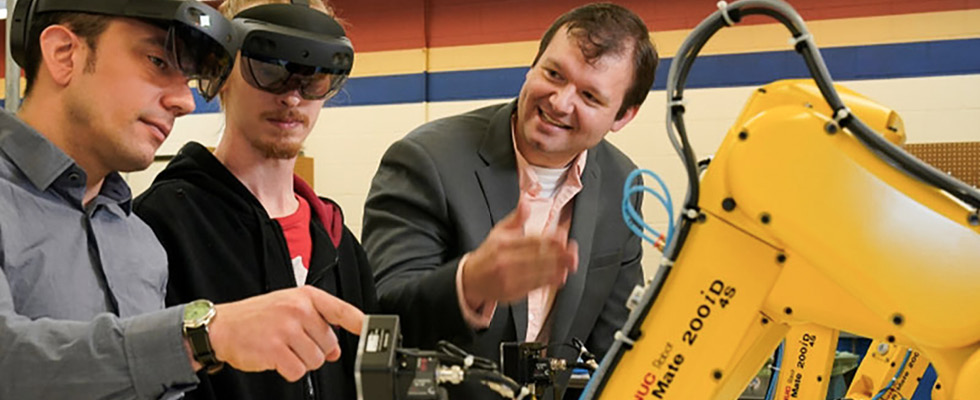
Dr. Justin Starr, endowed professor of advanced technologies at the Community College of Allegheny County (CCAC) in Pittsburgh, recently spoke at the Fall Annual Hydraulic Institute (HI) Conference in a presentation titled “Leveling Up Technical Training: Integrating HI certifications Into Community College Curricula.” In an interview conducted over Zoom, I sat down with Starr to discuss his presentation and what he views as the positives of adding HI certifications into a community college’s curriculum.
Starr’s appreciation for what community colleges can offer first began when he was a student at CCAC himself. He explained, “A million years ago, I started at a community college. So, I've always had a soft spot in my heart for the value they provide. They are in a region where they are the most affordable educational option for people finishing high school. They do such a valuable service to the community for building a workforce. I just can't overstate that enough.”
Before Starr was a professor of mechatronics, an interdisciplinary field focusing on the integration of various engineering disciplines, such as mechanical engineering, software engineering, robotics, etc., he was chief technology officer (CTO) for a company that made water and wastewater inspection robots. During that experience, he noticed that one thing holding the company back was their difficulty in finding skilled technicians. “I could get a ton of great Carnegie Mellon roboticists to design the next generation of robots, but getting technicians that build them to repair the circuit boards to actually, you know, do that level of analysis was just tough.” So, when Starr had the opportunity to sell the company, he decided to go back to community college to help build the programs that would create those badly needed technicians.
A big part of this initiative was CCAC’s decision to adopt HI certifications into the curriculum. Starr spoke about the importance of community colleges being tuned into the local workforce and its needs. In one anecdote Starr shared, he spoke about a local engineering firm that gave feedback on the college’s previous pump curriculum. In essence, the firm felt the curriculum was not providing students the practical skills needed to be a productive part of the workforce, and this conversation ultimately led to the idea to begin incorporating HI certifications in the classroom.
However, this may not have happened if CCAC had maintained what Starr called the “Advisory Board model.” Starr explained that community colleges in Pennsylvania have an advisory board whose role it is to advise professors on workforce needs so they can plan their lessons accordingly. The issue, Starr explained, is that in his experience, the reality of this model involved a single, annual meeting between the college’s faculty and industry professionals. The workforce members would have perhaps an hour to offer advice to the college, and given the brevity of this meeting and the industry’s position as simply advisory, Starr found it rare for meaningful conversations to take place.
In what Starr described as a radical shift, CCAC has shed the Advisory Board model in favor of a Business Industry Leadership Team (BILT). In this updated model, the industry has more of a leading voice in guiding CCAC. Rather than a single, annual meeting, the BILT model sees educators meet with industry professionals three to four times a year. In these meetings, industry professionals are able to tell the faculty precisely what they’re looking for in potential job candidates, and it is then up to the college to update their curriculum to meet the industry’s needs. In describing this transition, Starr said, “It's been like night and day since we started using the BILT model and mechatronics, which is our main program. Our job placement rate has been above 90%.Some semesters it's 100%.”
The recent introduction of HI certifications into CCAC’s curriculum is meant to further this idea of meeting the industry’s needs, and Starr explained that one thing he appreciates about the incorporation of the HI certifications is how seamlessly they are able to be integrated into what he called the “flipped-classroom model.” In contrast to the familiar image of a lecturer talking at students for an hour or two on any given day of class, this flipped model sees CCAC students getting the information they need for class through digestible videos before class ever starts. The HI certifications have been a perfect addition to this model, as they are available to students on multiple devices and are as easily digestible as the videos the students are already watching. This allows for actual class time to be spent hands-on in labs. As Starr explained to me, it’s one thing for a student to read about rebuilding a pump, but it’s another thing entirely to practice doing it themselves.
The Spring 2024 semester is the first semester in which the HI certifications have been introduced into CCAC curricula, but Starr already feels optimistic about what he’s seen. “Anecdotes are not data,” he explained. “But the feedback has already been overwhelmingly positive, and we’re looking at ways to do more.”
When I asked Starr if there was anything else he’d like to tell our readers, he mentioned that plenty more community colleges would love to incorporate methods like the BILT model or adding HI certifications to their curricula, and he would urge industry professionals interested in forming relationships with their local community colleges to do so. Starr concluded, “I’m sure they’d love to do something to help your workforce.”

